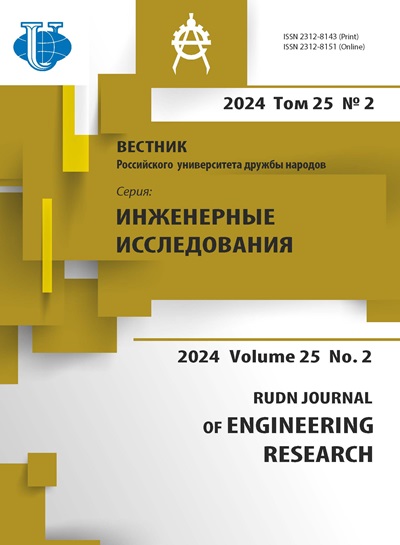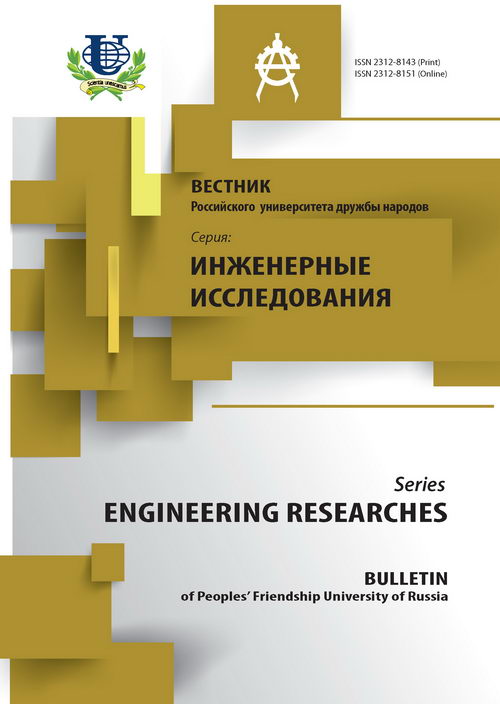Факторы, влияющие на критическую нагрузку и распространение местной потери устойчивости в сетчатых оболочках (современные достижения)
- Авторы: Хейдари А.1, Галишникова В.В.1
-
Учреждения:
- Российский университет дружбы народов
- Выпуск: № 1 (2013)
- Страницы: 118-133
- Раздел: Статьи
- URL: https://journals.rudn.ru/engineering-researches/article/view/4744
Цитировать
Полный текст
Аннотация
Настоящая работа является попыткой синтетического подхода к проблемам расчета и проектирования сетчатых оболочек, для которых главной задачей является обеспечение устойчивости. В работе представлена современная библиография по проблеме устойчивости сетчатых куполообразных оболочек. Рассмотрены несколько видов общей потери устойчивости конструкций, а также опасное явление распространение местной потери устойчивости их элементов. Представлены экспериментальные данные и сделаны теоретические выводы.
Об авторах
Алиреза Хейдари
Российский университет дружбы народов
Email: alborz.dimas@gmail.com
Кафедра строительных конструкций и сооружений Инженерный факультет
Вера Владимировна Галишникова
Российский университет дружбы народов
Email: galishni@gmail.com
Кафедра строительных конструкций и сооружений Инженерный факультет
Список литературы
- Galishnikova G., Dunaiski P., Pahl P.J. Geometrically Nonlinear Analysis of Plane Trusses and Frames. Sun Press, Stellenbosch, 2009.
- Kani I.M., Heidari A. (2007) Automatic Two-Stage Calculation of Bifurcation Path of Perfect Shallow Reticulated Domes, ASCE // Journal of Structural Engineering, 133(2), 185—194.
- Gioncu V. Buckling of Reticulated Shells, State-of-the-Art // Int. J. of Space Structure, Vol. 10, No. 1, 1995.
- Kato S., Yamada S., Takashima H., Shibata R. Buckling stress of a member in a rigidly jointed single-layer reticular dome. In Spatial Structure at the Turn of the Millennium, Proc. IASS Symp., Copenhagen, 1991, 109—116.
- Aquilar R.J. Snap-through buckling of framed triangular domes // J. Struct. Div. 93. ST 2. 1967, 301—317.
- Aquilar R.J. Huang T. The snap-through buckling of triangular lattice domes under the simultaneous application of concentrated loads. In space structure (ed. R.M. Davies) Blackwell Sc. Publ., Oxford. 1967.
- Balut N., Porumb D., Rennon N. The nonlinear analysis of reticulated shells (in Romanian). The 2nd conf. on steel structures, Timisoara, 1970, Vol. 1.
- Balut N., Porumb D., Gioncu V. Some aspect concerning the behavior and analysis of single-layer latticed roof structures. In stability of metal structures, Int. Coll. Paris, 1983, Prelim. Raport, 133—140.
- Carpenter W.C., Ely J.F., Bramer C.R. The joint instability of latticed structures under generalized load. In space structures (ed. R.M. Davies). Blackwell Sci. publ., Oxford, 1967.
- Gioncu V., Balut N., Rennon N. Interaction between different instability modes of lattice roof structures. 3rd Int. Coll. Stability, Timisoara, 1982, 262—272.
- Gioncu V., Balut N., Porumb D., Renon N. Instability behavior of triangulated barrel vaults. In Analysis. Design and construction of Braced barrel Vaults (ed. Z.S. Makowski) Elsevier, London, 1985, 159—182.
- Gioncu V., Ivan M. Buckling of Shell Structures (in Romanian), Ed. Academiei, Bucharest, 1978.
- Gioncu V., Lenza P. Propagation of local buckling in reticulated shells. In space structures 4 (ed. G.A.R. Parke, C.M. Howard), Conf. Guildford, Sept. 1993, th. Telfors publ., London, 1993, 147—155.
- Lenza P. Some developments in shells structural analysis. Proc. IASS Congr., Madrid. Vol. 1989.
- Lenza P. Sul comportamento non linear di volte reticulari cilindriche. Gior. Ital. della Costr. In Acciao, Capri, 1989.
- Lenza P. Non-linear behavior of reticulated cylindrical vaults. In spatial Structures at the Turn of the millennium. IASS Symp., Copenhagen, Vol. 3, 1991, 143—150.
- Lenza P. Instability of single layer doubly curved vaults. Int. J. Space Structures. Vol. 7, No. 4, 1992, 253—264.
- Lind N.C. Stability criteria for reticulated shells. IASS. Congr. Large span shells, Leningrad, Vol. 1, 1966.
- Lind N.C., Puranik B. The stability analysis of reticulated domes with grid discontinuities. Int. Conf. on Space Structures (ed. R.M. Davies), 1966, 439—444.
- Mateescu D., Gioncu V., Konrad C. Stability of symmetrical load latticed cylindrical roofs. The 3rd Int. Coll. on Stability, Timisoara, 1982.
- Matsushita F., Ohya T., Mukaiyana Y., Matsue Y. Study of the elasto-plastic buckling of single-layer domes. In space structures 4 (ed. G.A.R. Parke, C.M. Howard). Guildford Conf., Sept. 1983, Th telford publ., London 1993, 167—175.
- Mutoh I., Kato S. Comparison of buckling loads between single-layer lattice domes and spherical shells. In space structures 4 (eds G.A.R. Parke, C.M. Howard), Guildford Conf. Sept. 1993, The. Telford Publ., London, 176—185.
- Mutoh I., Ueki T., Kato S. On estimation of the buckling load of lattice domes by generalized slenderness. In Innovative large span structures (eds. N.K. Srivastava et al.), IASS congress, 1992. Toronto, 564—575.
- Oda K., Hangai Y. Snap-through buckling and tensional buckling of joint of single layer lattice shell. In Innovative Large Span Structures (eds. N.K. Srivastava et al.) IASS Congress, Toronto, 1992, 487—496.
- Oda K., Hangai Y., Ohya S. Loading test of torisonal buckling of joint of six member unit dome. In Nonlinear Analysis and Design for Shell and Spatial Structures (eds. Y. Hangai et al.) IASS Symp., Oct. 1993, Tokyo. 189—196.
- Savelyev V.A., Lombardo I.V. Study of non-symmetrical forms of buckling in single-net domes. In tension Structures and space frames, IASS Symp., Tokyo-Kyoto, 1971.
- Supple W.J., Collins I. Limit state analysis of double-layer grids. In Analysis and construction of double layer grids (ed. Z.S. Makowaski), Appl. Sci. Publ., London, 1981, 93—117.
- Ueki T., Mukaiyama Y., Kubodera I., Kato S. Buckling behavior of single layered domes composed of members with axial and bending springs at both ends. IASS Congr., Vol. 4, Madrid, 1989.
- Ueki T., Kato S., Kubodera I., Mukaiyama Y. Study on the elastic and elasto-plastic buckling behavior of single layered domes composed of members having axial and bending springs at the ends. In Spatial Structures at the Turn of the Millennium, IASS Symp., Copenhagen. Vol. 3, 1991, 93—100.
- Ueki T., Matsushita F., Shibata R., Kato S. Design procedure for large single-layer latticed domes. In space Structures 4 (eds. G.A.R. Parke, C.M. Howard) Guildford Conf., Sept. 1993. Th. Telford publ., London, 237—246.
- Janko L. Initial postbukling behavior of shallow saddle shaped hypar shells support by shear diaphragms under uniform load // Acta Techn. Acad. Sci. Hung., 97, No. 1—4, 1984, 133—175.
- Kato S., Takashima H., Shibato R. Effect of geometrical initial imperfections, relaxation at connectors and additional loads on ultimate strength of a semi-rigidly jointed single-layer reticular dome. Proc. 3rd summer coll. On shell and spatial structures, Taegu, Korea, 1990, 481—492.
- Kato S., Yamanda S., Takashima H., Shibata R. buckling stress of a member in a rigidly jointed single-layer reticular dome. In spatial structure at the turn of the millennium, proc. IASS Symp., Copenhagen, 1991, 109—116.
- Kato S., Shibata R., Ueki T., Matushita F. Buckling load estimation for single layer domes by the concept of column strength curves. In public Assembly structures from Antiquity to the present. IASS Symp., Istanbul, 1993, 507—512.
- Marinescu Gh. Reticulated shells (in Romanian) Ph.D Thesis, Bucharest.
- Sugizaki K., Kohmura S. Experimental study on buckling behavior of a triodetic aluminum space frame. In Nonlinear Analysis and Design for shell and spatial structure (eds. Y. Hangai et al.) IASS Symp., Oct. 1993, Tokyo, 205, 212.
- Stutzki Ch. Influence of connection stiffness on the stability of lattice shells. Int. Coll. Bolited and Special Structural Connections, Moscow, 1989.
- Zingali A. Analisi nonlineare e postbuckling delle coperture reticulari. Ist. di Sci. delle Costr., Univ. di Roma, Publ. II–215, 1977.
















